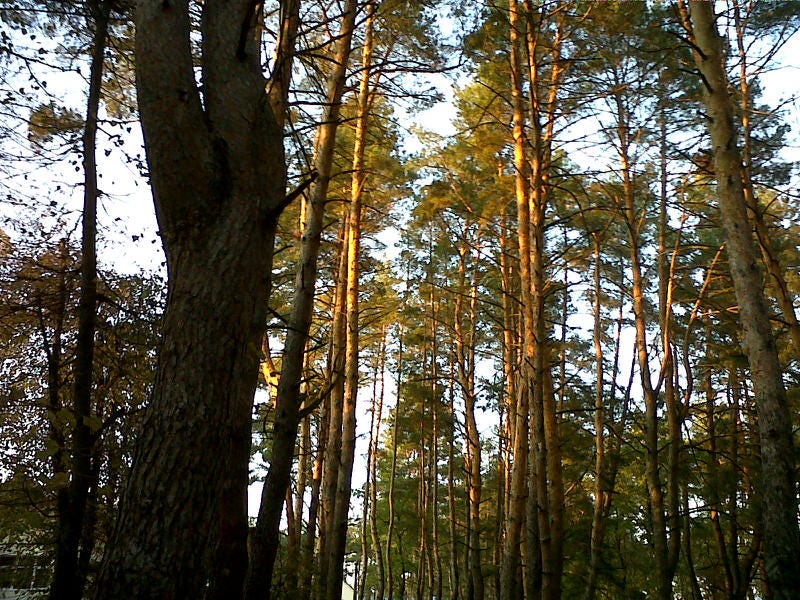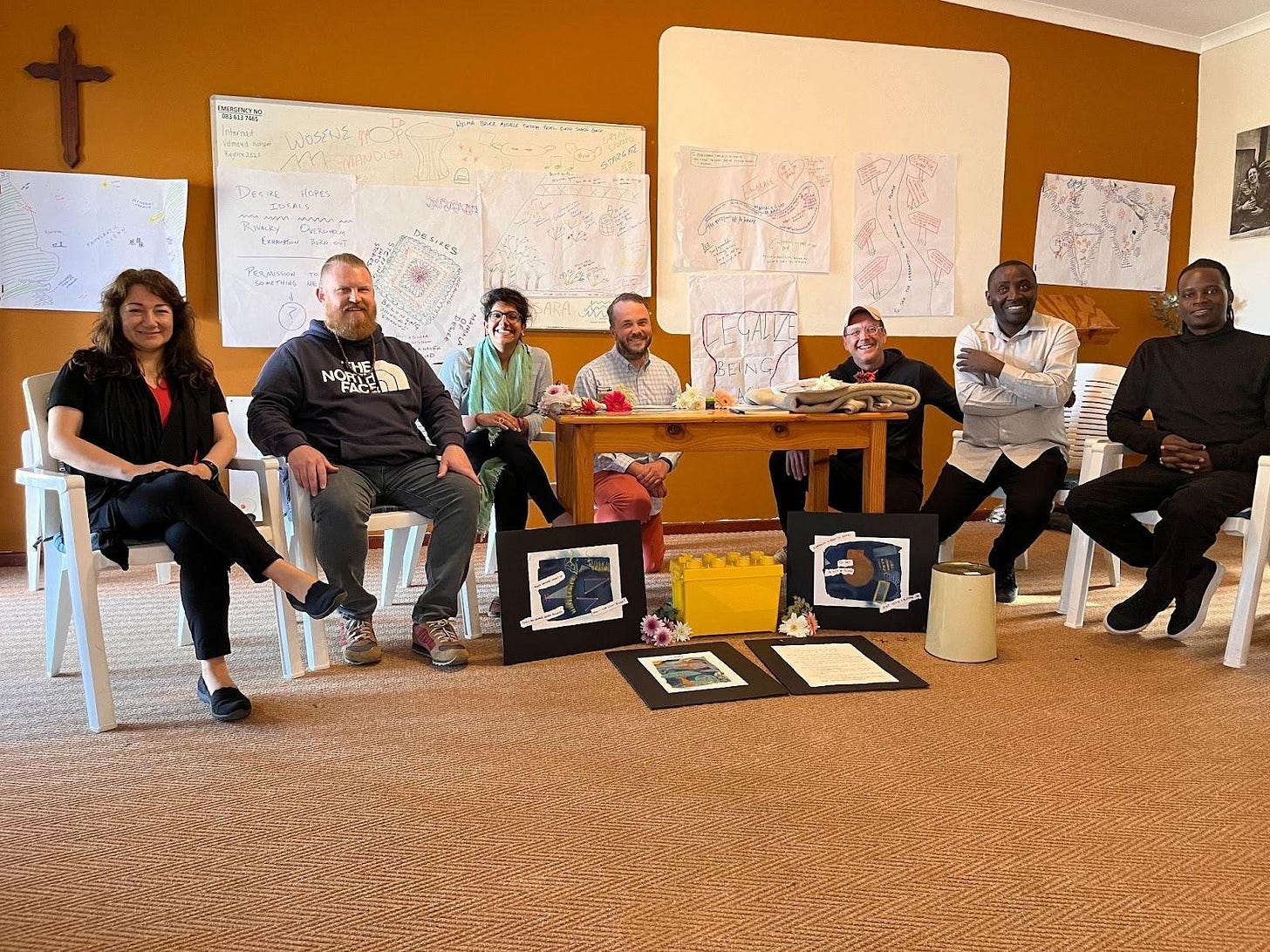Earlier this month, I shared the first of three related postings on gathering. I reflected on some of what I’ve learned in the past few years about what it means to bring people together, especially across lines of difference. Today, I want to follow up on my last post with a deeper dive on a key area of learning — the importance of creativity in gathering and organizing.
Sitting among the pine trees
I spent much of my career among theologically trained people, and I’m grateful for that. They often have a gift for wrestling with life’s big questions. I’ve grown from spending time in that world.
But I also noticed patterns in how and where people gathered. I lost count of how many meetings I sat through, on nearly every continent, in bland or even strikingly ugly rooms. And this wasn’t usually about money. Some of the most welcoming spaces I’ve seen were in rural corners of South Asia or West Africa. Some of the starkest, most lifeless ones were in wealthy institutions in big Western cities.
Over the years, I kept returning to a quiet question: how much does space matter? Can a flat, dull room flatten our thinking, too? Of course, the people matter most. I’ve seen amazing ideas emerge in some terrible rooms. But when I look back, I see a pattern: beauty in a space often unlocks something in the people gathered there.
I often think back to a visit to a seminary in Asia, about 20 years ago. At the time, they were between presidents and making small updates to the campus — a brighter entrance, a lighter cafeteria. These changes sparked debate. Some wondered if they were worth it.
I returned five years later and asked the current leader what he thought. He hadn’t been there during the renovations and paused to consider. “Maybe it did change things,” he finally said. The next day, he told me his wife had affirmed it more strongly: yes, those small changes made a difference.
Aesthetics matter.
I also remember a springtime meeting outside Kyiv, at a retreat center in a forest zone on the city’s edge. It was a beautiful place. But most of our meetings were indoors.
One breakout session took place in a small, stark-white room. Through a tiny window, we saw blue skies and pine trees stretching toward the sky. We moved outside. The sunlight on the trees was stunning. We decided to move our meeting outside.
I’ve forgotten most of that conference, but not that session. It was unusually creative, thoughtful, and connected. The change of venue helped us to see differently. It uncaged us, brought us into contact with the broader, wilder world.
Seeing from a different angle
A friend and former colleague, Billy Price, defines creativity as simply looking at something from a different angle. Creative processes are permission giving. When we see differently, we’re free to act differently.
Small changes — a remodeled entryway, a shift to meeting outdoors — gave that permission to be differently.
I now believe creativity is essential if we’re to see clearly. That’s not easy for me to say. I never used to think of myself as a creative person. I was more at home in academic systems that reward control and mastery. For a long time, I avoided emotional work, afraid of what it might stir up.
But in recent years, I’ve had the gift of walking with deeply creative people who’ve pushed and taught me. Thanks to them, I’ve come to see myself differently: as someone who is, in fact, creative.
People drawn to change-making often come from academic backgrounds, shaped by words and ideas. Graduate study tends to lead us deeper into methods that value analysis, objectivity, and repeatable results. These tools matter — they’ve helped us achieve a lot.
But if we rely only on our minds, we risk losing something important.
I often describe my time after finishing the PhD as a season of unlearning, at least in part. That journey sharpened my skills in asking questions and doing research, and I’m grateful for that. But it also trained me to ignore more intuitive ways of knowing, the kind that come from stories, bodies, and lived experience.
I’m still working to reclaim that.
Facilitating toward creativity
In the past few years, I’ve worked with collaborators to shake up the usual ways of thinking and being, often by using less-familiar creative tools like painting, storytelling, theater, drumming — even building with Legos. We started with a simple belief: to see more clearly, we have to see more creatively.
One of my greatest joys was hearing laughter as people painted “peaceful buildings” or built a sacred community tree from Lego bricks. These playful moments stretched our creative muscles and opened new ways of facing the challenges ahead.
In one gathering, we slowly placed our creative work at an “altar” in the meeting space (1). By the end of the week, it held art projects, flowers from the trees we’d met under, a blanket (to honor the cold that some participants struggled with), photos of loved ones, Lego creations, and hand-drawn maps of our desires for peace.
I saw the same creative energy in shorter conference settings. At one global gathering, we simply brought people into a circle — so they could actually see each other. This simple act of disruption was received as permission to interact differently. In another, we invited participants to work together on a recipe. That lighthearted task quickly opened up real conversations about work culture and power dynamics: Who takes notes? Who handles the coffee? In another online gathering, we invited people to break into groups and respond to stories through poetry, music, or visual art.
One of my greatest joys has been hearing how people have carried these practices home. One woman added drumming to her life after a retreat in South Africa; she says it helps her feel more connected to her body. A professor who hadn’t painted since childhood picked up a brush again; she now returns to it when her work feels overwhelming.
Creating amidst difference
These creative moments helped people experience real breakthroughs.
But even more powerful was what happened when people engaged creatively across lines of difference.
I have seen this creative power even in the act of coming to know one another. Most gatherings begin with “What do you do?” or “What have you achieved?” I’ve found it far more powerful to begin with “Who are you?” Again and again, I’ve seen the depth that emerges when people share their stories.
These moments are rarely neat and tidy. They ask for real listening, vulnerability, and often, a kind of translation across cultures or life experiences.
I felt this especially during a retreat when each person spoke about the meaning and origin of their name(s). Almost everyone had to pause and explain something — a detail that didn’t translate, or a reference that needed more context. These slow processes often brought surprising clarity. They helped us build shared meaning — and just as often, they revealed power dynamics we hadn’t named, opening them up to gentle curiosity.
Stepping outside our usual ways of working and thinking helps us see differently. It opens new possibilities — and sometimes, new problems.
At one 2024 conference, a simple group activity, creating a recipe together, led to real conversation about gender and power. It reminded me how creative practices, even small ones, can make space for deeper engagement with hard topics.
This shouldn’t surprise us. Traditional ways of gathering often protect existing power — by keeping the space for possibility small. But creativity, beauty, and shared exploration ask something different. They invite us to let go of control and open ourselves to what might emerge. (2)
Sustaining Creativity
What happens after moments of creativity — after the flash of light?
It’s one thing to spark creative energy; it’s another to sustain it. Even in stable times, this is hard. But many of the people I’ve worked with aren’t in stable environments. They’ve built something meaningful, only to find themselves facing a new phase of work, one that asks them to create again, almost from scratch.
In those conversations, I often hear undercurrents of exhaustion and isolation. Simply naming that feels grounding. It brings us back to a deeper question: how can we support change leaders in ways that keep creativity alive — especially when they’re feeling resistance.
One thing I’ve learned again and again: sparking creativity matters. A little disruption — a shift in how we see or where we meet — can make a big difference.
Sometimes it starts with the space itself. What if our meeting rooms invited imagination? What if our workspaces inspired connection?
But even more important is how we create the conditions for people to see from a new angle. When that happens, when something familiar is seen in a new light, that’s when the magic comes. That’s when connection deepens, and we begin to imagine together what else might be possible.
In the final part of this series, I’ll explore what I’ve learned about self-understanding and the power of personal narrative in our gatherings.
For Reflection
When have you experienced creativity unlocking new insight in a group setting? What conditions made that possible? How might you help create them for others?
Where in your current work or community life do familiar patterns feel constraining? What small, creative disruption could invite new ways of seeing or connecting?
How does the aesthetic of the physical and virtual spaces you gather in shape how people show up and engage? What’s one change you could try to invite more imagination, warmth, or presence?
What I’m reading/engaging
I recently finished Habits of the Heart by Robert Bellah and colleagues, a book I’d seen referenced for years but only just read. I was surprised to discover it was published in 1985, because it still feels remarkably relevant. The heart of the book, for me, is this: America has long struggled to balance individualism with a deep sense of community. The authors, like de Tocqueville before them, warn that without strong communal ties, individualism can leave space for tyranny to grow.
I’ve also been following Ivan Krastev’s geopolitical reflections, most recently in a conversation with Yascha Mounk. His insights into the collapse of the Soviet Union — and how that history echoes in our present moment — have stayed with me.
And I continue to find Jason Lewis’ substack essential reading. He and I both spent time in the evangelical change-making world, and his bold reflections on philanthropy’s blind spots are challenging and timely.
A Final Note
I recently relaunched my professional website — this time with the links working (thanks to those who let me know!). The site shares more of my story, the questions that drive my work, and the kinds of support I offer.
If you’re looking for someone to help design or hold creative, reflective spaces — whether for a team, community, or personal process — I’d love to connect. My work includes coaching, facilitation, research, and story-based exploration (including genealogy and narrative work).
I’ll be sharing more in the coming weeks, but if any of this resonates now, feel free to reach out.
(1) I’m indebted to my engagement with The Resonance Network for this idea. They have taught me much about gathering.
(2) I’m grateful to Mary Putera of The Art of Integrity who has taught me much about the relationship between creativity and power.






